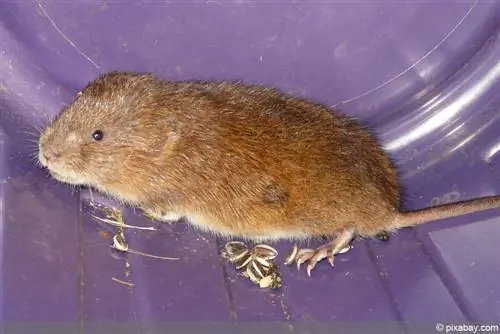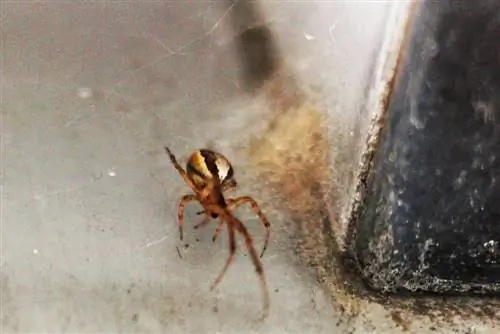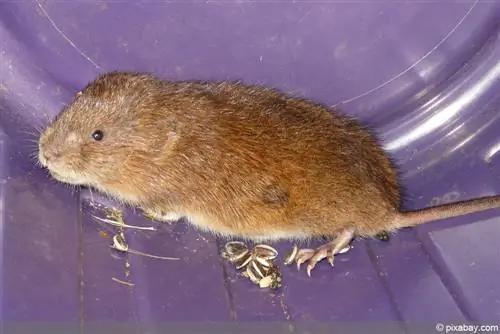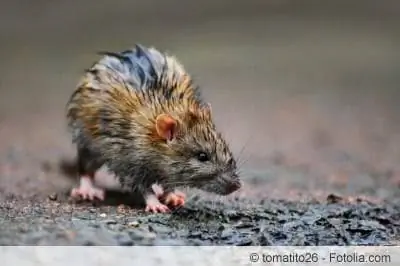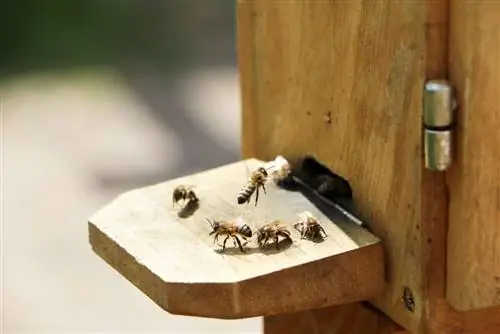- Author admin [email protected].
- Public 2023-12-17 03:39.
- Last modified 2025-01-24 12:45.
If your own garden has been infested with voles, this is not only annoying, but it can also be harmful to vegetables, flowers and even trees. Therefore, if you notice a vole, you should act immediately. Unlike moles, they are not protected species, so they can be killed. You can use live traps or poison bait to combat the voles, although the animal welfare aspect should still be in the foreground despite everything. This means that even if the pest is killed with poison, it must not suffer and it must be done quickly.
Vole trap
The generally most effective method of successfully combating voles are special traps that can be purchased commercially. There are different types, such as the SuperCat trap, the pincer trap, box traps or the Bavarian vole trap. However, before traps are used to combat vole infestations, it must be ensured that it is not a species-protected mole in your own garden that must under no circumstances be caught or killed. The situation is different with voles, which are not subject to the Endangered Species Protection Act and can therefore be controlled at any time. But setting up traps, with the exception of the box trap, is not for animal-friendly hobby gardeners. When setting up all traps, the following should be taken into account:
- the traps are used in the corridors
- Ideally choose two traps at the same time
- one at each exit
- often several animals live in the corridors
- then it makes sense to dig more than two traps
- If the traps are baited, moles avoid the traps
- Baits can be pieces of apple, celery or carrot
Shock traps
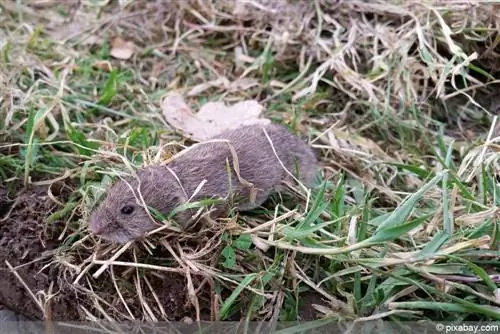
These traps destroy the voles; a hard blow kills the mouse immediately upon contact. They only catch in one direction, so several traps must be set up in one corridor. Ideally always opposite, then the vole will definitely fall into one trap or another.
Topcat or Supercat trap
This trap is also a pure death trap for the voles. It consists of a stainless steel tube that is precisely adapted to the movement of the voles. The trap is inserted in the middle of the corridor because it catches from both sides. This trap does not need to be baited, as the voles automatically come across this trap when crossing their tunnel and are killed by a firing pin when touched.
Pincer trap and Bavarian vole trap
These two traps are also traps for killing the pests. They both have to be baited, the spring has to be tensioned and the traps have to be pushed far into the passage. The only difference in these traps is that the pincer trap can catch in both directions, while the Bavarian vole trap is made of a wire basket and only catches in one direction.
Box trap
The box trap is a live trap. She also needs bait because she only catches on one side. Once the vole is in, it can't get out. It can then be removed from the passage with the trap closed and released again in a distant forest.
Tip:
If an acute plant death suddenly begins in your own garden that is actually inexplicable, it is advisable to look for the hills typical of voles. Because then it may be that the garden has been infested with voles, which eat the roots of many plants underground. The mounds can be easily distinguished from the molehill because the opening for the voles is on the side. Traps may only be used if it is certain that it is not a mole.
Bait
Baits are only laid out in conjunction with poison, or placed in a trap as bait. However, only bait such as pieces of carrot, apple or celery that are not laced with poison are placed in the traps. These only serve to attract the voles and fall into the traps. Poison bait, on the other hand, is available ready-made in stores and should under no circumstances be made yourself. The ideal time for all kinds of bait is autumn and winter, because then the voles, who are active even in winter, can no longer find enough other food and are therefore more receptive to the bait.
Fighting with poison
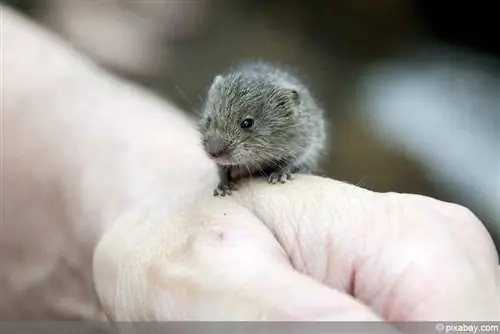
Fighting with poison should always be done very carefully and with great care. Other animals can also be affected and if pets or small children are part of the household, it is better to avoid this. Poison bait or poison wheat should only be applied in autumn or winter, because during this time the pests find less food and therefore respond more quickly to bait. When fighting with poison, it is helpful to consult an expert who is familiar with the legal regulations of the respective municipality or country. There are other things that should be taken into account when using poison bait:
- Voles ignore the bait or drag it into their burrow
- If the bait stays there longer, the poison loses its effect
- Poison bait must never be displayed in public
- always only place in the passages of the voles
- Use zinc phosphide-based poison as ready-made bait
Tip:
Under no circumstances should hobby gardeners make poison bait themselves. So-called poison wheat is available commercially and can be used according to the manufacturer's instructions. In the event of a larger infestation, an expert should always be consulted before using poison.
Vole gas
Vole gas is also often used against pest infestations. Calcium carbide is usually used here, which releases acetylene in combination with other chemical substances and in reaction with water. The gas is available in the form of granules, is scattered into the corridors and, when exposed to moisture, develops into a poisonous gas that releases phosphine. But even if the passages are closed immediately after the granules have been sprinkled in, so that the gas can fully develop in the passages and does not flow outwards. However, this usually does not achieve the desired result; the voles do not die from the gas, but are usually driven out of their burrows. You should also pay attention to the following:
- if the soil is sandy, the gas can escape
- never use a higher concentration on your own
- this could be dangerous for the surrounding area
- always follow the manufacturer’s instructions
- professional fumigation of the vole burrow has a greater effect
- therefore only use the gas for distribution
- should the voles be killed, call in experts
- Fighting with gas is useful all year round
Conclusion
Many different traps are available commercially that effectively combat voles. The live trap is of course still the most animal-friendly, as after catching the vole it is simply released again far away. The other traps, on the other hand, kill the pests quickly and reliably, but in this way the dead animals then have to be removed from the traps and disposed of. The use of poison, on the other hand, should always be carried out with great caution; if in doubt, an expert should always be consulted. Especially if small children or pets live in the household, you should avoid using poison to combat them.

